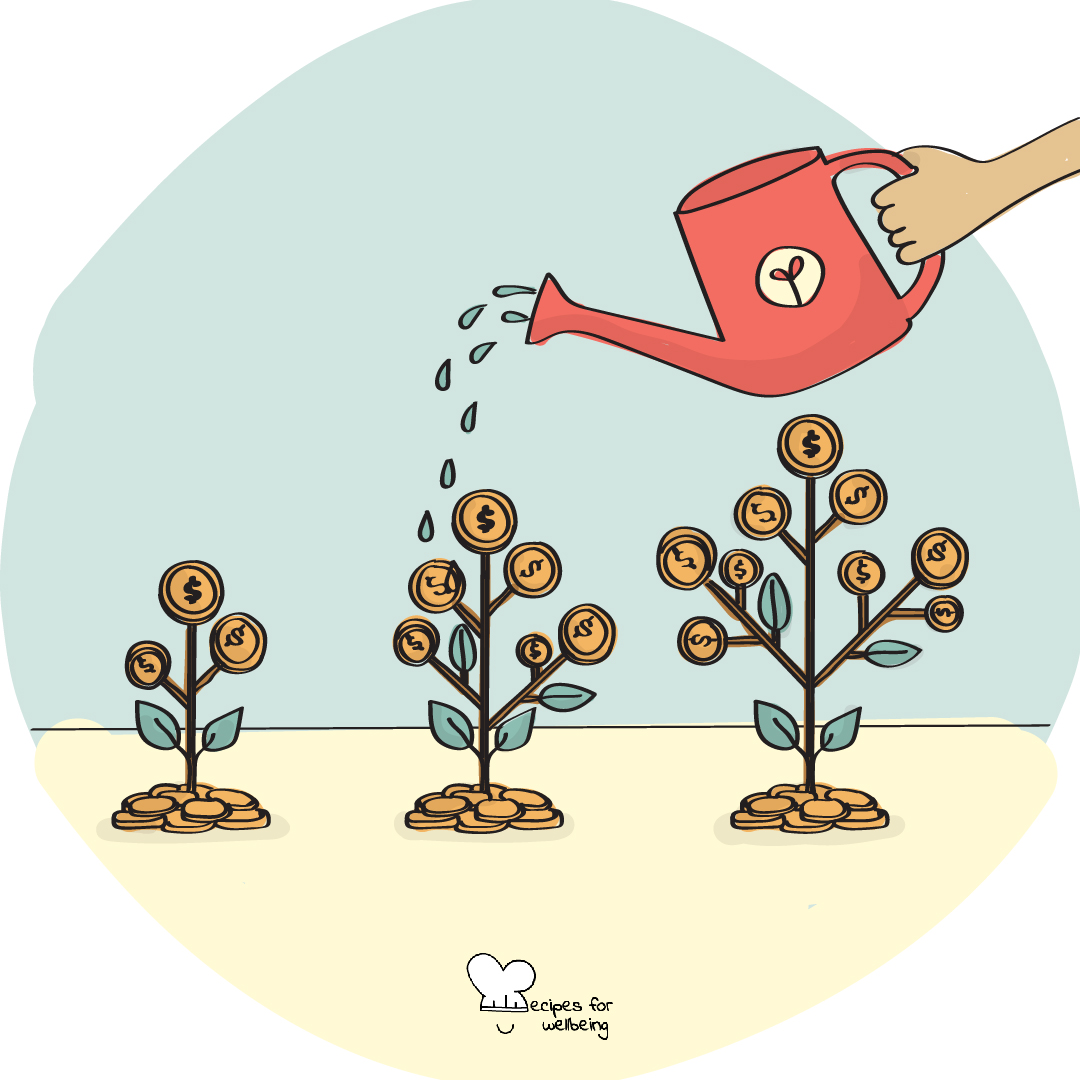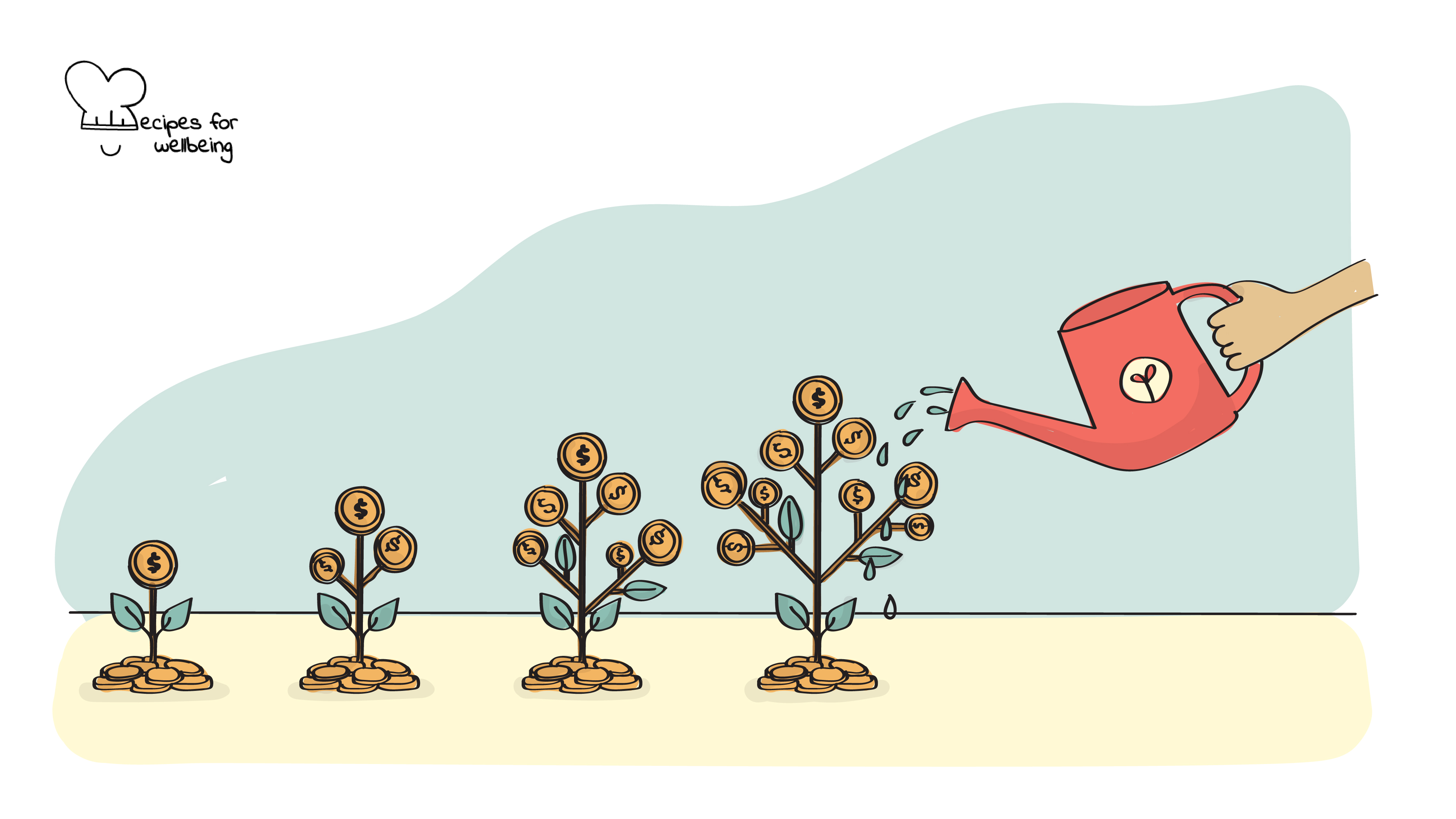
Community Wealth Building
Wealth is the ability to fully experience life. ―Henry David Thoreau
👥 Serves: 26-40 people, 41+ people
🎚 Difficulty: Medium
⏳ Total time: Ongoing
🥣 Ingredients: Open mindedness and creativity
🤓 Wholebeing Domains: Community, Liberatory Learning, Meaning
💪 Wholebeing Skills: Autonomy, Co-creation, Collaboration, Community-building, Equity, Inclusion, Non-extracting, Service

Community Wealth Building
📝 Description
Strategies for community-centred economic development.
Consider a healthy, happy tree. You may wish to think of Community Wealth Building exactly like fostering a healthy tree. A healthy tree has extensive roots in the soil that are anchored firmly in place. The roots give them a home and allow the tree to hold firm through wind, hail, and snowstorms. This reflects local small businesses that have pride and roots in their community that can survive hard times and economic hardships. The roots help instruct the tree to flourish with luscious branches that can be tended to by locals. The tree can then benefit the local community in many ways: it can shade people; it can bear fruit which profits people in many ways; it requires attention and care from many wise and creative hands fostering a sense of community and ownership; it can support mental health as a refuge to get into nature; it can be chopped down to create new items/products/furniture/books; and its seedlings can go onto grow neighbouring trees that will benefit the peoples for centuries. The branches reflect various businesses that can prosper. A healthy tree is remarkably sustainable, just like community wealth building.
Community Wealth Building is an economic framework that places value on individuals and communities to foster wealth through plural ownership of the economy, rather than the traditional individualistic approach. Building community wealth strives to harness the assets, talents, and abilities of communities so that the profits rendered stay within that community, helping it to prosper, and offering its citizens a sense of control over their finances and ultimately, their livelihood.
Community Wealth Building is inspired by the European Social Democratic tradition, whereby the state aims to protect the public value and create a happy, prosperous community. Community Wealth Building strives to create various financial avenues, by enhancing and creating small locally owned and operated businesses, co-operatives, employee-owned or partnered companies, and social enterprises that give back to the area.
Do note that there is no “one-size-fits-all” model of community wealth building. Rather, the focus should be on it being a bottom-up approach that centres around autonomy and democratic ownership of the economy. This means that each local attempt at community wealth building will likely be different, based on the local context, culture, ecosystem, resources, and politics.
This recipe has been inspired and adapted from the work by the team at the Democratic Collective by our wellbeing content writer collaborator Marissa Del Mistro.
👣 Steps
Step 1 – Create tangible strategies
Community Wealth Building must be as inclusive as possible, with even the most vulnerable in mind. To do this, tangible strategies need to be written to ensure that the wealth trickles down to the community members who need it the most, and with it, an abundance of opportunities. These strategies can be written in collaboration with local community leaders, municipalities and organisations.
Step 2 – Focus on plural ownership of the economy
Under traditional models, wealth is accumulated and held by a small majority of key stakeholders. For example, ever since 2015, the richest 1% has owned more wealth than the rest of the entire planet. What’s more, almost 3.4 billion people live on less than $5.50 a day.
Through Community Wealth Building, the notion of people reaping the benefits of economic growth is at the heart. When opportunities and assets (assets are resources with economic value) are locally owned and operated, they are more likely to continue to invest that money back into their community by employing, buying, and investing locally. This translates into local prosperity, greater community stability, and a solid network of local people and businesses.
To have more people involved in economic prosperity, and for a thriving economy, there should be ample opportunities for wealth building enterprises. This could look like worker ownership, co-operatives, community-owned businesses, and municipal enterprises. This formula is advantageous to the community, with profits handed back to a small percentage of shareholders/investors.
Step 3 – Ensure just accessibility to capital
Harnessing sufficient capital is imperative for creating new small and locally owned businesses. Typically, this comes in the form of a loan from a bank, an investment firm, angel investors or, more rarely, family and friends. However, with many banking institutions focused on self-preservation, the securement of loans and funds means smaller enterprises may struggle to receive the capital or have to compete with international investors, driving up costs and taxes.
There are many options for capital in investment portfolios. Imagine the exciting possibilities if these investments were harnessed towards building local community prosperity? Community Wealth Building strives to work with investors/banks to create affordable capital that is committed to building local wealth. To get started, if this is not possible, small businesses could consider crowdfunding or fundraising initiatives.
Step 4 – Sustainability for all
Having accessible local jobs rejuvenating the community is key, but how that is harnessed over the whole community matters, too. For example, if the cost of everyday items or things like gas and electricity is too expensive for people to thrive holistically, the household incomes are tightened, and ultimately the local economy suffers.
To avoid this, local services should ultimately be owned in the true interest of the community. This could look like co-operative or municipal ownership to ensure they are affordable and that profits can be invested. To make this an sustainable economic endeavour, the priority is creating local relationships that can be harnessed for the good and offer mutual, long-lasting support. Fostering collaboration between all levels of business, government, organisations and residents are intrinsic to the success of any model of building community wealth.

